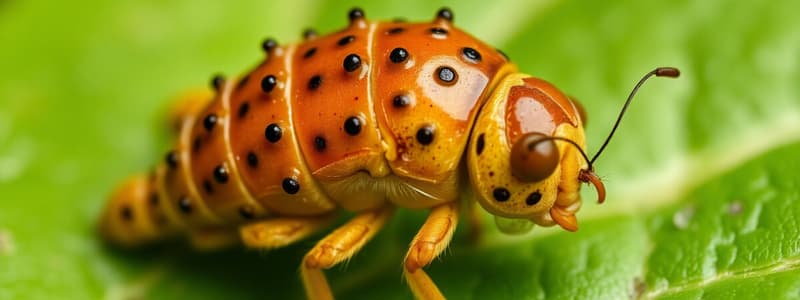Podcast
Questions and Answers
What is the primary purpose of respiration in living organisms?
What is the primary purpose of respiration in living organisms?
- To remove waste products
- To increase size and dry mass
- To detect environmental changes
- To release energy for metabolism (correct)
Which of the following characteristics is NOT common to all living organisms?
Which of the following characteristics is NOT common to all living organisms?
- Nutrition
- Photosynthesis (correct)
- Reproduction
- Sensitivity
Which characteristic involves an organism's ability to maintain its internal environment?
Which characteristic involves an organism's ability to maintain its internal environment?
- Movement
- Excretion
- Growth
- Sensitivity (correct)
What does growth in living organisms specifically refer to?
What does growth in living organisms specifically refer to?
Which of the following is involved in the process of excretion?
Which of the following is involved in the process of excretion?
Flashcards
What is Respiration?
What is Respiration?
The chemical processes in cells that break down nutrient molecules and release energy for metabolism.
What is sensitivity?
What is sensitivity?
The ability to detect and respond to environmental changes, both internal and external.
What is Excretion?
What is Excretion?
The removal of waste products of metabolism and excess substances.
What is Growth?
What is Growth?
Signup and view all the flashcards
What is Reproduction?
What is Reproduction?
Signup and view all the flashcards
Study Notes
Characteristics of Living Organisms
- Living organisms share seven key characteristics: movement, respiration, sensitivity, growth, reproduction, excretion, and nutrition.
- All seven characteristics must be present for an organism to be considered living.
Groups of Organisms
- Animals
- Plants
- Bacteria
- Fungi
- Protoctists
Movement
- Movement involves a change in position or location of an organism or part of an organism.
- Examples include an organism walking or a plant's leaf turning towards the sun.
Respiration
- Respiration is the breakdown of nutrient molecules, releasing energy for the organism's life processes (metabolism).
- Metabolism is the collection of chemical processes keeping the organism alive.
Sensitivity
- Sensitivity refers to an organism's ability to detect and respond to changes in its internal or external environment.
- This allows organisms to maintain their internal stability.
- Examples include plants responding to light, temperature, or water level changes.
Growth
- Growth involves a permanent increase in size and dry mass.
- Dry mass is the mass of an organism after all water has been removed.
Reproduction
- Reproduction creates new organisms similar to the parent.
Excretion
- Excretion involves removing waste products from metabolism and substances not needed by the organism.
- Examples of waste products include urea and carbon dioxide.
Nutrition
- Nutrition is the intake of materials for energy, growth, and development.
Studying That Suits You
Use AI to generate personalized quizzes and flashcards to suit your learning preferences.




